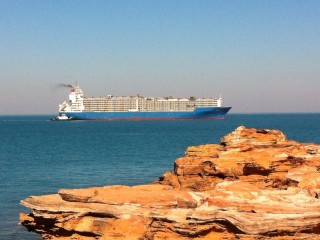 One of the world’s largest livestock vessels is making her maiden voyage as a livestock carrier this week, transporting 17,000 cattle from Western Australia to Egypt.
One of the world’s largest livestock vessels is making her maiden voyage as a livestock carrier this week, transporting 17,000 cattle from Western Australia to Egypt.
The MV Nada is owned by a syndicate of Middle Eastern investors who have a long history in supplying livestock from Australia and other international ports to the Middle East.
The 200m vessel was recently converted from a container ship to a livestock carrier in China, and has been designed to exceed AMSA (Australian Maritime Safety Authority) requirements, which represent the highest certification standards in the world.
With 29,000 square metres of livestock capacity, the Nada is the largest single tier livestock-deck configured carrier in the world.
“Single tier” configurations have only one floor of livestock pens per deck, as opposed to “double tier” configurations which use mezzanine levels to create two floors of livestock per deck.
Wellard Rural Exports’ MV Ocean Shearer at 37,700 square metres, also a converted container ship, was previously the largest single tier livestock vessel in the world, but is understood to have recently been taken out of commission. Her replacement, a smaller, purpose-built ship based on the design of the MV Ocean Drover, is currently being constructed in China and is expected to be delivered later this year.
Western Australian based John Edwards, who represents one of the major owners of the MV Nada, Suleiman Al Jabri Trading Establishment from Jeddah, Saudi Arabia, said the vessel’s design incorporates state-of-the-art ventilation, feeding and watering systems, along with a livestock penning layout that is designed to ensure safety and comfort for livestock and ease of loading and unloading.
Mr Edwards, who is also chair of the WA Live Exporters Association, told Beef Central last Friday the investment in the Nada represented a significant financial commitment by the group in the future of the live export trade, particularly at a time when the industry is facing increasing regulatory turmoil and rising costs.
“This is a process that started more than three years ago, and the project was well and truly on its way when the new ESCAS regulations came into force,” Mr Edwards said.
“Obviously for the owners of the vessel, it had a significant impact on trading possibilities going forward for some of the countries that may or may not adopt the ESCAS requirements.”
Mr Edwards said regulatory imposts created by ESCAS had added up to $30 per head to the price of Australian cattle in Middle Eastern markets, and over $10 per head for sheep.
The additional costs were making it more difficult for Australian exporters to compete against the many other suppliers that sell livestock into the price-sensitive region.
The introduction of ESCAS into Indonesia last year and the “tranche one” markets of Turkey, Kuwait, Bahrain and Qatar in March this year has coincided with declines in Australia’s livestock exports to those markets, he said.
“They are all now casting the net far and wide looking for alternative livestock supplies that come without a regulatory impost, because ESCAS has a cost attached to it,” Mr Edwards said.
“We are the only industry and country in the world that invests in bettering animal welfare practices abroad, and the basic arithmetic is that in some respects we are seeing ourselves forced out of the market.”
Orders to Egypt rise
The Egyptian market has emerged as one of the rare bright lights on the live export industry horizon in the face of dramatic reductions in the key market of Indonesia.
The recent construction and approval of a second “closed loop” feedlot and processing facility at the point of disembarkation in Egypt is expected to improve Australia’s capacity to supply livestock into the region.
This week’s journey by the Nada, carrying 17,000 cattle assembled primarily from northern WA by International Livestock Exports (ILE), will be followed by a second shipment of similar numbers from another exporter into the new closed-loop facility in mid-July.
ILE principal Mike Stanton said Australian live exports faced strong competition in Egypt from South America in particular.
Transport distances from Australia and South America to Egypt were roughly the same (Broome to Sohkna is around 15-16 days), meaning that orders often came down to who could supply cattle at the best price. That in turn was affected not just by local cattle prices but exchange rates and fodder costs.
At the moment the equation is working in Australia’s favour, which is good news for northern WA producers desperate for an alternative to Indonesia.
The market is taking bos Indicus steers up to 450kg with a maximum of four teeth, and paying around $1.50-$1.60/kg.
While that is less than the $1.70-$1.75 price for cattle to Indonesia, it provides a valuable outlet for heavier cattle that exceed the Indonesian weight limit, and lighter feeder weights as well.
Mr Stanton said the Nada was exceptionally well designed in terms of feed and water capacity and penning arrangements.
It took just 30 hours from start to finish to load the 17,000 head cargo in Broome, he said.
